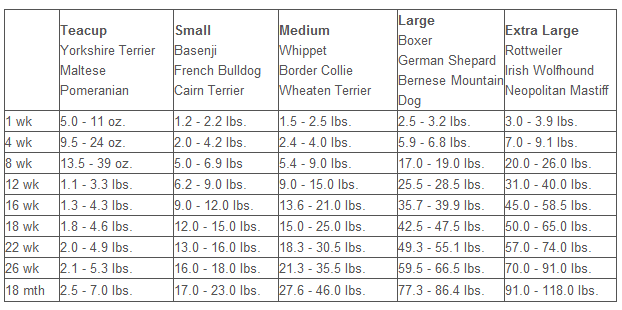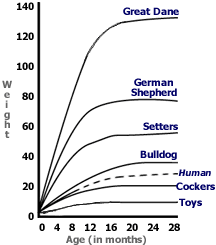Most new puppy owners are interested in projecting how large their pup will grow.
Here’s a handy chart..


A French Bulldog is considered a small to medium breed dog depending on the Sire and Dam size and weight.
One of the first questions anyone asks when considering purchasing a dog or puppy is how big will it get? This is a very relevant and important question considering your need to ensure your puppy is cared for appropriately in your home.When predicting adult size, the two easiest formulas to remember are FOUR FOLD and DOUBLE UP.
Double Up: Generally, an adult dog will weigh about twice as much as he did when he was 4 months of age; giant breeds will double what they weighed at 5 months.
Four Fold: The weight of your puppy at 8 weeks is a quarter of his adult weight.
With the above factors taken into consideration, it is possible to make a reasonable guess of a puppy’s weight at maturity using the Four Fold and Double Up formulas.
You can also obtain the weight of the sire (father) and dam (mother) of purebred puppies. Female puppies will weigh about what their dam weighs. Male puppies will weigh about what their sire weighs.
Try Puppyweights.com to help figure out your puppy’s adult size and weight.
Factors Affecting Growth
While much of a French Bulldog's growth is determined by genetic factors, early environmental factors also affect growth. Puppies who nurse frequently in the first weeks of life get better nutrition and are more likely to grow quickly. A healthy diet after your puppy is weaned can also affect her growth rate. Puppies who don't get enough food or who get low-quality food may end up smaller. Overfeeding can cause your dog to become obese. Medical conditions may also affect growth. French Bulldogs who are sick in the first few weeks of life tend to be smaller.
Estimating Adult Size
You can estimate your puppy's adult size by weighing her at eight weeks. Be sure to get the weight in ounces, since French Bulldogs don't grow very large and a few ounces can make a difference. Double this number and then double it again. For example, if your French Bulldog is 88 ounces at six weeks, double it to get 176 ounces, then double the number again to get 352 ounces. Divide this number by 16 to get your dog's weight in pounds. The 88-ounce puppy will be about 22 pounds as an adult.
Growth Rate
On average, French Bulldogs tend to grow to their full size (height at the withers and length from the base of their neck to their rear-end) between the ages of 9 months to a year, and then they tend to "fill in" and bulk-up during their second year, fully maturing by the time they're around 2.
During their growth stages, puppies can certainly grow to be heavy, and then they start getting leaner and more toned in their second year, so it's not unusual for a puppy to be heavier when they're under a year, and then drop a couple of pounds in their second year.
Big Dogs Equal Big Litters Puppies
According to the American Kennel Club, one of the biggest factors in litter size is breed. Small-breed dogs, such as Chihuahuas, do not have room in their bodies for large litters, therefore they tend to produce only two to four puppies per pregnancy. Large-breed dogs, such as Great Danes, usually have larger litters, 10 to 12 puppies being common. Breed type also impacts the size of the newborns. Small-breed puppies are typically several inches smaller than large-breed puppies, regardless of the number of dogs in the litter.
Small Puppies the Mother's Health
Unusually small puppies are not a result of large litters. Instead, their size can usually be traced back to the health and nutrition of the mother dog before and during her pregnancy. Because the unborn puppies share the nutrition she takes in from her food, she needs an ample diet to properly nourish the puppies. Without sufficient food, the puppies will not reach appropriate size and may suffer health problems. According to veterinarian Kathleen Hefner, writing for the American Kennel Club, most puppies who die soon after birth were probably born from malnourished mothers.
Litter Size Problems
Even though litter size does not impact puppy size, large litters can cause problems for the mother dog and her new babies. If the mother's uterus attempts to carry more puppies than she can physically handle, her life and the puppies lives can be threatened. Also, large litters tend to produce more stillborn puppies and runts. With so many neonatal puppies vying for nutrition, those in the center of the womb often do not get sufficient nourishment, which can cause them to be born small or to die. Great Pyrenees breeder Catherine de la Cruz warns that large litters can trigger earlier-than-expected whelping, which can be a problem for the puppies unprepared human grandparents.
Predicting Litter Size
While accurately predicting the size of an expectant mom's litter is difficult, some other factors do contribute. Research shows older mother dogs have smaller litters than younger canine moms. Also, dogs who had their first litter at an older age will have smaller litters. The mother's weight can be a factor. Obese female dogs tend to have smaller litters than healthy-weight dogs. However, any pregnant mom can experience a large litter relative to normal within her breed.
Dog litter sizes vary from one puppy to more than a dozen newborns. The recorded largest litter had 24. While litter size can impact many aspects of whelping and raising puppies, it does not actually impact the size of the individual puppies. The parents genes, the puppys breed, and the mother's health and nutrition determine the puppies size at birth.
